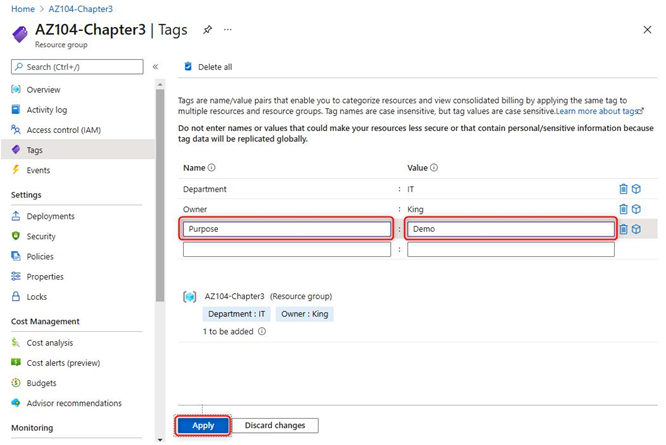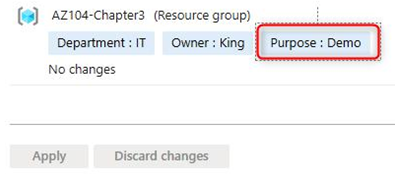When implementing a tagging strategy, it’s important to consider the requirements for having tags in place. Tags will assist in presenting value to either business or information technology (IT)-aligned tagging requirements. The key to implementing a defined tagstrategy is consistency, in the application of tags as well as the implementation (especially on the casing). Some important common tag patterns are noted here:
- Functional: Classification of resources by defining the functionality the resource(s) introduces to the workload environment.
Application Name: Use this to classify a set of resources for an application.
Environment: DEV/TEST/UAT/STAGING/PROD/DR.
- Classification: Thistag can be used to describe data classification pertaining to resources. This is particularly valuable for compliancealignment, such as with the General Data Protection Regulation (GDPR).
Confidentiality: Private/Public/Restricted.
- Accounting: Thisset of tags is particularly focused on cost governance and the assignment of resource(s) to a billing unit/entity within the organization. Department: Finance/IT/HR/Marketing/Sales.
Region: West Europe/ Central US, and so on.
- Partnership: Thisset of tags is used to identify people in the organization who can or should be contacted as they contain relevance to the resource.
Owner: Identify the product owner for the service.
Support Email: Identify who to contact when needing support.
Business Criticality: Define how important the resource is to the business (normally a metric value such as BC1/BC2/BC3).
SLA Objectives: Define a service-level agreement (SLA) tier that would apply to determine the support required for the service (for example, SLA Tier 1/SLA Tier 2/SLA Tier 3).
- Purpose: Thisset of tags is reserved for understanding the key deliverable for the application and is aligned to a business objective.
Purpose: Describe the application purpose in a single line. This assists later in troubleshooting by creating a basic understanding of what the application is and does.
Applying a resource tag
For this example of applying a resource tag, we will open a resource group on the portal, open the tagging section, and apply a tag. The steps are outlined here:
- Open the resource group and select Tags, as illustrated in the following screenshot:
Figure 3.36 – Tag example
- Apply a tag name and value pair (or multiple pairs), and click Apply. We have created a new tag named Purpose with a value of Demo, as illustrated in the following screenshot:

Figure 3.37 – Applying a new tag
- After being applied, you will get a notification; notice the changes in the section above the Apply button. To modify a tag, we simply update the value, as illustrated in the following screenshot, and click Apply:

Figure 3.38 – Applied tags overview
Now that you know how to configure and apply tags, you will learn the PowerShell commands to assist with the management of tags.

Leave a Reply